Diane Arbus the Writer
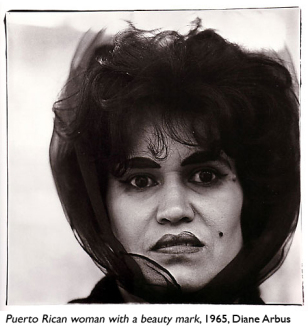 Some people express themselves well visually, others are great writers, and a lucky few are talented in both areas. Diane Arbus was one of the few who could do both. Known for her intimate, unflinching photographs of society’s fringe-dwellers, Arbus also wrote with the verve and originality of a true writer. That was the opinion put forward by two heavyweight writers—Michael Cunningham and Francine Prose—during a recent evening at the Museum of Modern Art celebrating Diane Arbus, wordsmith.
Some people express themselves well visually, others are great writers, and a lucky few are talented in both areas. Diane Arbus was one of the few who could do both. Known for her intimate, unflinching photographs of society’s fringe-dwellers, Arbus also wrote with the verve and originality of a true writer. That was the opinion put forward by two heavyweight writers—Michael Cunningham and Francine Prose—during a recent evening at the Museum of Modern Art celebrating Diane Arbus, wordsmith.
I was excited about this program, which took place as part of the 2012 PEN World Voices Festival. I love Francine Prose, both for her novels and for her 1998 Harper’s magazine essay Scent of a Woman’s Ink, in which she asked why women’s writing is not taken as seriously as men’s (a question that was recently renewed by Meg Wolitzer in the New York Times). And although I had mixed feelings about The Hours, I have great respect for Michael Cunningham and like his attitude to writing as expressed in this New York Times essay.
So there we were in Theater 2 at MoMA—but as the lights went down, the audience was time-traveling to a lecture hall near NYU in 1970, with Arbus’s voice coming out of the dark. We were watching A Slide Show and Talk by Diane Arbus, a rarely-screened film that reconstructs a lecture given by Arbus in 1970. “Do you want to know what my favorite thing about photography is?” are the first words Arbus says, giggling a little. “I always thought it was kind of a naughty thing to do.” Her voice is flutey, girlish. She sounds like Little Red Riding Hood, equal parts knowing and naive.
She then goes on to show a range of images that have inspired her. Some are highbrow (an Edward Curtis photograph of a Native American chief is “a terrific Indian picture”) but most are tabloid clippings with grisly or absurd themes. Petty criminals; ugly girls getting makeovers; kids stuffing their faces with pie. One, a smiling engaged man and woman taken a few weeks before their murder, draws her because it’s “so goddamned still” and “doesn’t forecast anything.” (This theme would surface again in 1971, when she wrote that photographs “are the proof that something was there and no longer is. Like a stain. And the stillness of them is boggling.”)
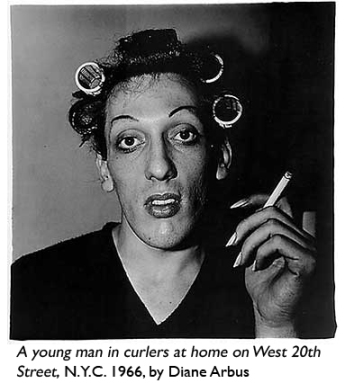 I noticed that the 1970 audience was amused and discomforted by some of this material. There was a lot of laughter over the tabloid shots, which Arbus didn’t seem to mind, even cracking jokes of her own. (“You always wonder how much your parents would have paid for you,” she said, referring to her fascination with the Lindbergh baby kidnapping.) But when it came to showing her own work, she seemed more perplexed by the laughter. “I don’t know what’s so funny,” she protested, seeming genuinely taken aback when her image of a naked waitress at a nudist camp drew a huge guffaw.
I noticed that the 1970 audience was amused and discomforted by some of this material. There was a lot of laughter over the tabloid shots, which Arbus didn’t seem to mind, even cracking jokes of her own. (“You always wonder how much your parents would have paid for you,” she said, referring to her fascination with the Lindbergh baby kidnapping.) But when it came to showing her own work, she seemed more perplexed by the laughter. “I don’t know what’s so funny,” she protested, seeming genuinely taken aback when her image of a naked waitress at a nudist camp drew a huge guffaw.
This brings us to the issues of invasiveness and voyeurism, which are always big flashpoints when discussing Arbus’s work. Midgets, nudists, transvestites: she photographed margin-dwellers, people who are not meant to be celebrated. Regular families were “creepy” to her—but what did she want people to take away from her images? And what was she prepared to do to get them? Germaine Greer wrote a memorable description of how Arbus literally pinned her to a bed during a shoot that became something of a psychological wrestling match. The result was an image Greer found to be “an undeniably bad picture.” For Greer, Arbus’s creativity “was driven by disgust.”
So, was she a cynical exploiter or a compassionate collaborator? To be honest, I think she was a little of both. In the film, I was surprised to hear her laugh over the fact that a young Brooklyn man and wife she portrayed very movingly with their Down Syndrome son were “incredibly inarticulate.” That sounded pretty judgmental—but later, talking about a wealthy society woman, she showed unexpected empathy, saying how she was “terrifically moved by that lady.”
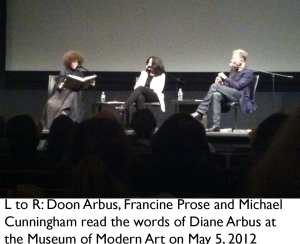 If she seemed girlish and vulnerable in her spoken delivery, leaning heavily on a select few adjectives like “naughty” and “terrific,” Arbus’s writing was far more nuanced and original. This became apparent after the movie when Cunningham, Prose and Doon Arbus took turns reading from Diane Arbus: A Chronology, a new book that features Arbus’s writing and doesn’t include a single photograph.
If she seemed girlish and vulnerable in her spoken delivery, leaning heavily on a select few adjectives like “naughty” and “terrific,” Arbus’s writing was far more nuanced and original. This became apparent after the movie when Cunningham, Prose and Doon Arbus took turns reading from Diane Arbus: A Chronology, a new book that features Arbus’s writing and doesn’t include a single photograph.
Francine Prose read from a high school essay Arbus wrote on Chaucer, in which she described the Medieval poet seeing things “like a newborn baby,” with wonder and curiosity and a lack of judgment. No wonder this appealed to Arbus, Prose said: she did it too. (Take that, Germaine Greer!)
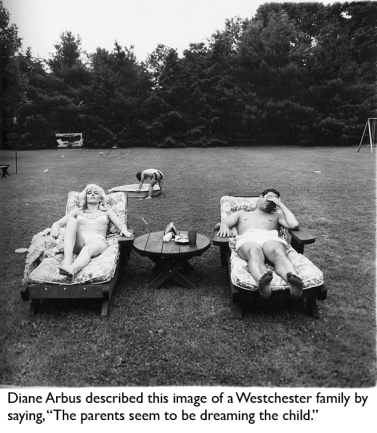 Michael Cunningham loved a line Arbus wrote about her picture of a Westchester family, that “the parents seem to be dreaming the child.” “Anyone who writes a sentence like that is a writer,” he said.
Michael Cunningham loved a line Arbus wrote about her picture of a Westchester family, that “the parents seem to be dreaming the child.” “Anyone who writes a sentence like that is a writer,” he said.
Then there was Arbus’s description of Hubert’s Museum, an underground freak show emporium near Times Square:
Coming in to the unholy fluorescent glare of it you’d see yourself dwarfed and flattened and stretched in several distorting mirrors and all around you like flowers a thousand souvenirs of human aberrations, as if the world had quite literally stashed away down there everything it didn’t need.
Unholy fluorescence: “Those of us who think of ourselves as writers would kill for a phrase like that!” said Prose. One of the things that makes Arbus’s sentences fun to read is “the rhythm: they just roll along,” she said. Cunningham wondered if, when she planned a photograph, Arbus went through a similar mental process as he does when he creates a character, first focusing on the person’s weaknesses. Doon Arbus shot this down, saying, “I think she was the exact opposite. In the best photographs there’s no opinion, judgment falls away.” (Germaine Greer might have walked out at that point.)
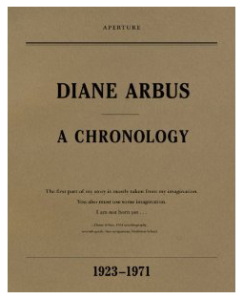 Since the event, I’ve been reading Diane Arbus: A Chronology. Generally, I’d say this is a book for hardcore Arbus fans, since it goes into an exhausting level of detail about her day-to-day life. There are moments of exquisite prose, like the ones pulled out at the MoMA event, but there’s also a lot of prosaic stuff relating to the vicissitudes of the artist’s life. “Sudden money panic… I owe 1800 not counting normal next month bills and taxes” is not likely to draw sighs of envy from Michael Cunningham.
Since the event, I’ve been reading Diane Arbus: A Chronology. Generally, I’d say this is a book for hardcore Arbus fans, since it goes into an exhausting level of detail about her day-to-day life. There are moments of exquisite prose, like the ones pulled out at the MoMA event, but there’s also a lot of prosaic stuff relating to the vicissitudes of the artist’s life. “Sudden money panic… I owe 1800 not counting normal next month bills and taxes” is not likely to draw sighs of envy from Michael Cunningham.
And yet, Arbus has some writing chops. Her writing is inflected with the same curiosity, delight and weird originality that informs her best pictures. Let’s not forget, too, that her brother was the distinguished poet Howard Nemerov. I’ll end with some text Arbus wrote for the magazine Artforum, to accompany a portfolio of her images that was published two months before her suicide in 1971:
Once I dreamed I was on a gorgeous ocean liner, all pale, gilded, cupid-encrusted, rococo as a wedding cake. There was smoke in the air, people were drinking and gambling. I knew the ship was on fire and we were sinking, slowly. They knew it too, but they were very gay, dancing and singing and kissing, a little delirious. There was no hope. I was terribly elated. I could photograph anything I wanted to.
Nothing is ever the same as they said it was. It’s what I’ve never seen before that I recognize.
… A photograph is a secret about a secret. The more it tells you the less you know.
8 comments on “Diane Arbus the Writer”
Leave a Reply
Connecting to %s

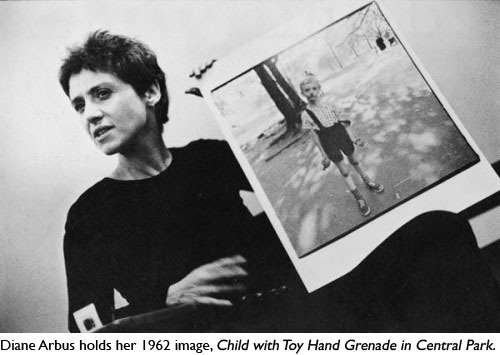
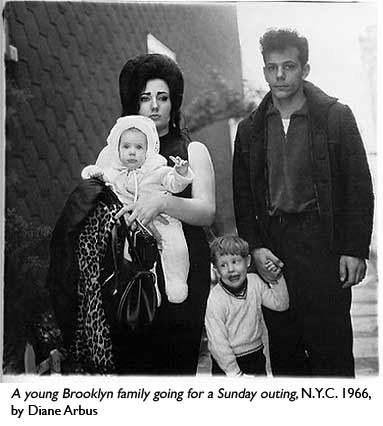

Almost every spring, in the Documentary Photography class I teach at MIT, we have what I call the “Diane Arbus” food fight. Inevitably it begins when some student, usually a young woman, tells us how much she likes Arbus – who otherwise does not come up in the class, and then precedes to tell us that Arbus captured the reality of the lives of the “freaks” with whom she identified.
I understand that Arbus is considered a great artist, but I would contend that what she really was was a bully with a camera, who projected her own pathology onto her subjects. No one, who claims to have empathy for, to care about, the developmentally disabled who looks at Arbus’s images of the older Down’s Syndrome patients in Halloween patients could conceivably see a compassionate photographer. There is nothing freakish about those people, and yet she quite deliberately made them appear utterly freakish. The photo of the king and queen of the dance at the senior citizen’s center? Were those your grandparents or parents, would you consider that a compassionate, or honest, photograph? Does that image of two tired elderly people capture their true personality? Or does it show them at their worst, something at which Arbus excelled?
One of the best examples of Arbus being Arbus is the famous photo of the Boy with the Grenade. Look at image that is so often displayed, and then look at the contact sheet of the shoot. The image chosen by Arbus for printing is the most distorted, most ‘unrealistic,’ image on the sheet. It is not, in fact, even the best photograph – there is another image, also quite compelling, in which the boy, with arms and legs somewhat splayed, looks like a normal child playing – not like an Arbus freak.
Every semester, I tell my students – long before we have our Arbus food fight – that the one, the only thing they owe their subjects is honesty. If their subjects are ugly, they should portray them as they are; they should not try to make them beautiful, but neither should they try to make them uglier. If they are poor, that’s how they should be portrayed, and so on. Diane Arbus chose as her subjects many of the outcasts of society. But she did not portray them as they were, she portrayed them as she apparently saw herself. In doing so she may have been helping herself, but she certainly wasn’t being honest with, or fair to them.
Thanks, B.D. Your Arbus food fights sound kind of fun… maybe you should take along some donuts next time and see what happens!
Interestingly, when that image of the boy with the toy hand grenade came up in the slide show, Arbus admitted that “he was exasperated with me.” I think she herself realized there was something voyeuristic in what she chose to do, as evidenced by her repeated use of the word “naughty.” But I also found her to be somewhat self-deprecating and modest in the slideshow film — something you wouldn’t necessarily equate with a bully. She said, for example, that “I take rotten pictures. It’s just that thing of doing it so goddamned much.”
I’d be interested to read about how some of her subjects reacted to the images she made of them. Have you ever read anything about that? I haven’t. It’s mentioned in ‘A Chronology’ that she kept in touch with some of her subjects, but not what they thought of the pictures. Yet the boy with the hand grenade and the New Jersey twin girls are probably still alive. Hmm — maybe I’ll try to dig around and see what’s out there.
I believe the Washington Post did a story about the “Shining Twins” when the big Arbus show was in D.C., and the twins did not have happy memories of their brush with Arbus – except for the fact that their father, very smart man, put in a safe deposit box a print, or prints, that Arbus gave them. And I know that some place in the past couple of years I have read a piece about “Grenade Boy,” and he too was not pleased with how he was portrayed. The interesting thing about both those cases is that they involve “normal” people made to look quite odd, normal people who are still around to speak for themselves.
One thing I should make very clear is that I consider Arbus an important artist, and artists stretch all sorts of envelopes, including those that contain our standards of decency, fairness, and honesty. It’s when one considers her as a “street photographer,” or “documentary photographer,” that I believe one sees very basic standards violated.
Here’s that Washington Post article. It’s very interesting. Includes interviews with the grown-up twins, the boy with the toy grenade and Anderson Cooper, who I’d forgotten was one of the babies Arbus photographed: http://wapo.st/ITkYcz
Just bought the book… excited to read now, thanks for the post!
I think the below passage written by Arbus shows the compassion she felt for some of her subjects who otherwise would not have been “noticed” or were alternately stared at by those unable to look away. Arbus developed personal relationships with her “freaks”, giving them, I suspect, a feeling of pride and respect — an emotion that was most likely unfamiliar to them…..”Freaks was a thing I photographed a lot. It was one of the first things I photographed and it had a terrific kind of excitement for me. I just used to adore them. I still do adore some of them. I don’t quite mean they’re my best friends but they made me feel a mixture of shame and awe. There’s a quality of legend about freaks. Like a person in a fairy tale who stops you and demands that you answer a riddle. Most people go through life dreading they’ll have a traumatic experience. Freaks were born with their trauma. They’ve already passed their test in life. They’re aristocrats.”
Great post Sarah. Its hard to separate the myth from reality (and various later interpretations of the reality she supposedly portrayed) when it comes to Arbus and I think that complexity will always be there both in terms of her work and her life. Still, nothing can take away from the impact her work has had.
When I see many of the photos of Diane Arbus, I know it’s a blessing to not be ill, or mentally disabled.